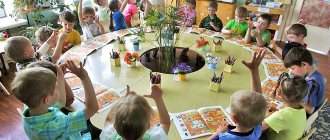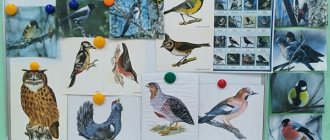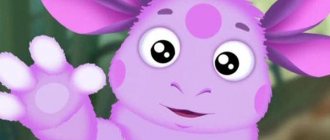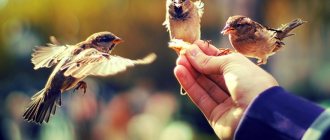Didactic games for older preschoolers 5-7 years old. Topic: Wintering birds
Didactic games for children of the senior preparatory group of kindergarten on the topic “Wintering birds”
Author: Pavlova Vera Valerievna, teacher of the special group of the Municipal Educational Institution "Bendery Kindergarten No. 9", Bendery Abstract: I offer a variety of didactic games and exercises for the formation of cognitive interest and speech activity, attention and logical thinking on the lexical topic "Wintering Birds", which are intended for educators and parents. Purpose: the proposed material will be useful in the implementation of educational activities, in joint and independent children's activities. Age audience: children of senior preschool age (5-7 years) Goal: formation of cognitive and speech activity of children by including a variety of games and exercises on the topic “Wintering birds” Objectives: - clarify and systematize children’s knowledge about wintering birds of the region (Moldova); -expand your vocabulary by forming complex words and consolidate the agreement of nouns with numerals; -develop memory and thinking, develop the ability to give reasons for your answers; - consolidate knowledge of proverbs and sayings about wintering birds. Didactic game “Guess what kind of bird, according to words and descriptions” Purpose: to consolidate the characteristics of wintering birds, to develop the ability to form complex words (red-breasted, long-tailed, etc.). Progress of the game: The teacher helps the children look at pictures of birds and says that he will name four words that suit this wintering bird.
Pupils listen carefully to the words and show a picture of a wintering bird. Then one child explains the answer. If the answer is correct, you can reward the child with a chip. Second version of the game: when consolidating the material, you can invite the children themselves to be the presenters and make wishes for wintering birds one by one. Didactic game “Recognize a bird by body parts” Goal: recognizing the external appearance of wintering birds of the region and developing speech skills to justify your answer. Progress of the game: The teacher shows the children a picture of nine birds, which are partially hidden under snowflakes.
Children guess the birds and explain their answers. If you give a correct, reasoned answer, you can reward your child with a chip. Explanations for teachers: In Moldova, wintering birds include: mute swan; nuthatch; sparrow; Great Grebe; hawk; magpie; gray and white heron; tit; mallard ducks; bullfinch and others. Didactic game “Lay out wintering birds according to the pattern” Goal: correlating wintering birds and geometric shapes, laying out a chain of four birds using modeling technology Progress of the game: The teacher shows large cards on which wintering birds are depicted and symbols under them - geometric shapes of different colors.
Children have small cards with images of wintering birds (6 pieces).
Each child has one long card with geometric shapes.
Children, under these figures, lay out the birds that these figures represent according to the model. Option two: when fixing the material, the birds and shapes can be changed and the number of geometric shapes can be increased to 6 (if the children can handle it). Option three: you can have a conversation: 1. Which bird is your first? Third? Fifth? 2. Swap the third and fifth birds with each other. Which bird is now third? Etc. Explanations for teachers: in the presented game, wintering birds from the region of Moldova were selected, and teachers from other regions and countries can easily replace these birds with birds from their region. Didactic game “Count the birds” Goal: recognizing wintering birds by their external and distinctive features and matching nouns with numerals. Progress of the game: Teacher: Guys, there is a feeder in front of us and birds have flown to it. What kind of birds are these, help me guess? Children explain their answers. Now let's count how many birds flew to the feeder? Why do you think so? (For example, I saw three titmouse tails, which means there are three titmouses) If the answer is correct and reasoned, you can reward the child with a chip.
Didactic game “Be careful!” Goal: summarizing information about wintering birds (appearance, habitat, nutrition, care of offspring, characteristic features, etc.) Progress of the game: Each child is given a card with a picture of nine wintering birds of the region and chips.
The teacher explains that for each wintering bird you can choose words that will help you talk about it. Children listen carefully to the word describing a wintering bird and use counters to cover one or another bird. Then they explain their choice. If the answer is correct and reasoned, you can reward the child with a chip. Cheat sheet for teachers: Vocabulary: small, lively, forest, gray, flying, dexterous, red-breasted, swims, agile, urban, jumping, cheerful, swamp, chirps, brave, omnivorous, smart, hollow, big, lively, long-tailed, cheerful, dragonfly, predatory, snow-white, white-sided, long-legged, small, agile, diving, hunting, wintering, waterfowl. Didactic game: “Collect a proverb” Purpose: to consolidate proverbs and sayings about wintering birds and explain the meaning of proverbs. Progress of the game: The teacher explains that parts of proverbs and sayings are mixed up, we need to help correctly restore the beginning to the end. If children do not yet have reading skills, then the teacher himself reads (children of the older group). Option one: the teacher reads the beginning, the children finish the proverb. Option two: the children read the end of the proverb, remember the beginning. Option three: children alternately read the beginning of the proverb, then the end. Proverbs and sayings about wintering birds: The magpie knows where to spend the winter. A woodpecker does not peck at a healthy tree. No matter how much a raven croaks, it will never be a nightingale. Birds have strong wings, and people have friendship. A young sparrow learns to tweet from an old one. The bird is red in plumage, and man is in skill. The titmouse is a small bird, and it remembers its holiday. Every bird flies to its flock. The word is not a sparrow; if it flies out, you won’t catch it. Each bird feeds with its own nose. The tit is a bird across the sea. Where the crow did not fly, but fell into the claws of a hawk.
Didactic game: “Guess the rebus - find out what kind of bird it is” Goal: developing skills for the ability to guess words - rebuses, using knowledge of prepositions. Progress of the game: The teacher offers children pictures with encrypted words - puzzles. Children need to guess the words and explain their answer.
Cheat sheet for teachers: Answers to puzzles: bullfinch, crow, sparrow, magpie. Didactic game “Help the Sparrow” Goal: to develop skills in passing labyrinths. Progress of the game: The teacher offers to help the sparrow get to the feeder by walking through the maze. Children complete the task independently.
Have fun playing with your students!
Presentation on the topic: Didactic games “Wintering Birds”
We recommend watching:
Summary of educational activities on cognitive development in the middle group. Friends for a sparrow Summary of OD on familiarization with the outside world in the middle group. Wintering birds Summary of a lesson on familiarization with the environment (preparatory group for school). Topic: Wintering birds Didactic games for older preschoolers 5-7 years old. Theme: Winter
Similar articles:
Winter games for older children in kindergarten
Card index of didactic games on the topic: “Wintering birds”
Transcript
1 Card index of didactic games on the topic: “Wintering birds” 1. Word game: “The birds have arrived.” Goal: Develop auditory attention, activate vocabulary on the topic “Birds”. Description: The teacher names the birds, but makes mistakes. Children should notice the mistake and react by clapping, stomping, etc. Birds have arrived: pigeons, tits, flies and crows... pigeons, tits, storks, crows, bullfinches, macaroni... pigeons, tits, mosquitoes, magpies, cuckoos... pigeons, tits, storks, cuckoos, owls, buns, swans, starlings Game exercise "In the winter dining room." Goal: To consolidate children's knowledge about wintering birds and their names. Develop the ability to imitate their habits. Equipment: Silhouettes of birds, a branch on a stand, a feeder. Description: The teacher fixes the silhouette of a bird on a branch and draws the children’s attention to which bird flew to the feeder. He offers to name her and show how she screams. Children name birds, imitate their sounds, depict how they fly and jump.
2 3. Speech game “Who gives what voice?” Goal: To strengthen children’s ability to imitate birds. Description: Children are divided into pairs. The first child imitates the voice of a bird, the second child guesses what kind of bird it is. 1st child: “Tweet-chirp”, 2nd child: “It’s a sparrow tweeting.” 4. Game “Flies, doesn’t fly.” Goal: To develop auditory attention in children and cultivate endurance. Description: Children sit in a semicircle, placing their hands on their knees. The teacher names the objects and asks: “Does it fly?” (“Does a dove fly? Does a plane fly?”). If an object that flies is named, the children raise their hands. If a non-flying object is named, you should not raise your hands. 5. Ball game “Give me a word.” Goal: To develop auditory attention in children, to activate the verb dictionary on the topic. Description: The teacher throws a ball to the child and names a bird. The child catches the ball, returns it to the adult and pronounces the appropriate verb. Dove (coos). Cuckoo (cuckoos). Crow (caws). Sparrow (chirps). Tit (squeaks). 6. Exercise “Complete the sentences.” Goal: Development of thinking, activation of the dictionary of antonyms, development of the ability to coordinate nouns with pronouns in gender and number. Description: The teacher begins a sentence, the child selects the appropriate word and finishes the sentence. The sparrow is small, and the stork... The crow is large, and the tit... The owl sleeps during the day, but hunts. The tit has a short tail, and the magpie... The woodpecker has a long beak, and the bullfinch... The tit has a thin beak, but the woodpecker has a large crow, and the sparrow
3 Which of the wintering birds can you say about? Mine - (woodpecker, bullfinch, sparrow, dove), Mine - (crow, tit), Mine - 7. “Where is which bird?” Goal: To develop the ability to recognize wintering birds and migratory birds, to name them correctly; develop the ability to navigate in space, using in speech the concepts “above”, “below”, “left”, “right”, “between”, “under”, “above”, “on”. Equipment: Scene picture “At the feeder”. Description: The teacher invites the children to look at the birds that have flown to the feeder and name the birds that are to the left of the bullfinch, sitting under the roof, on the roof, between the magpie and the bullfinch, located under the sparrow, etc. 8. Game “Who’s missing?” Goal: To develop the ability to form nouns in the genitive case; development of memory, visual perception. Equipment: Subject pictures depicting wintering birds. Description: 5-6 pictures of wintering and migratory birds are laid out on the board or table, and children are asked to name all the birds and remember them. Then the children close their eyes, at which time the teacher removes one of the pictures. Children open their eyes and name which bird is gone. 9. Game “Recognize the bird by its silhouette.” Goal: To help consolidate children’s knowledge about wintering and migratory birds, to practice their ability to recognize birds by their silhouette. Description: Children are offered silhouettes of birds. Children guess the birds by naming whether the bird is migratory or wintering. 10. Game “Wintering and migratory birds.” Goal: To strengthen children’s ability to classify birds by migratory and wintering species. Description: Birds are located on two circles: bullfinch, starling, tit, sparrow, rook, cuckoo, woodpecker, swallow, crow, nightingale. The children's task is to place migratory birds in a circle with the sun, and wintering birds in a circle with a snowflake. 11. Speech exercise “Say kindly.” Goal: To strengthen children’s ability to form nouns and adjectives with diminutive meanings.
4 Sharp beak - sharp beak Thin paws thin paws Long neck long neck White chest white breast Black wing little black wing 12. Guessing riddles: How can we forget: They could fly away, But they stayed to winter Together with people. Their food is not rich, they only need a handful, a handful of grain and they are not afraid of winter. (Wintering birds) A small bird has legs, but cannot walk. Wants to take a step. It turns out to be a jump. (Sparrow) Chip-tweet! Jump to the grains! Peck, don't be shy! Who is this? (Sparrow) Motley fidget, Long-tailed bird, Talkative bird, The most talkative. The White-sided Prophet, And her name is (Magpie) What kind of table is this among the birches in the open air? In the frost he treats the Birds with grain and bread. (Feeder) Kar-kar-kar! Kar-kar-kar! That's the whole repertoire. Announces the maple crown with His singing (crow) Red-breasted, black-winged, Loves to peck grains, With the first snow on the mountain ash He will appear again. (Bullfinch) They don’t fly to a warm land, They sing in the cold, These small birds are called (titmouse). Even though I’m not a hammer I knock on wood: I want to explore every corner of it. I walk around in a red hat and I’m a wonderful acrobat. (Woodpecker) Flies all night, catching mice. And it will become light. He flies into the hollow to sleep. (Owl)
5 13. Folk wisdom on the topic “Wintering birds”: A forest without birds and birds cannot live without a forest. The bird knows that it is no good without the Motherland. Every bird is proud of its feather. Every bird sings in its own way. Every bird is fed with its beak. Each bird has its own habits. The sparrow immediately takes off, but the rook needs a run. A crow cannot be a falcon. The little crow's nest is his home. The titmouse is small, but its claw is sharp. The tit eats a little, drinks a little, and lives happily. A magpie doesn't chirp for no reason. The magpie brought the news on its tail. Owls and owls feast in the night. The sparrows are under the roof, and the owls are out to catch. The nightingale sings for a month, and the crow croaks all year round. The cuckoo crows and mourns about the house. No matter how much the cuckoo crows, it will fly away by winter. The material was prepared by teacher-speech therapist Efremova S.E.
- how many people are infected with coronavirus today in Russia number of infected today





